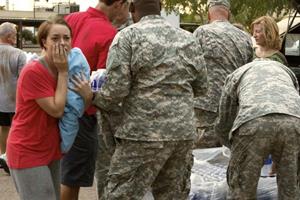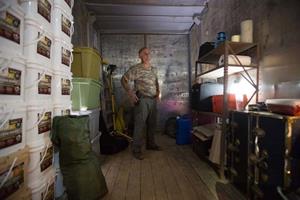Hard to believe the Northeast Blackout was a decade ago. Some of us recall the New York blackout way back in 1977, and the one before that, in 1965. Only the second of the trio led to large-scale social disorder.
The 1965 blackout turned into a big Go-Go party, and inspired the Doris Day movie comedy, Where Were You When the Lights Went Out? In 2003, only a handful of the 55 million Americans (in the Northeast and Upper Midwest) and Canadians (in the province of Ontario) who lost power died, most from carbon monoxide poisoning. In 1977, riots and looting swept across 31 New York neighborhoods, especially Crown Heights and Bushwick in Brooklyn, and along dozens of blocks of Broadway, torched to cinders.

The National Geographic Channel's fakeumentary, American Blackout (9 p.m. ET, NatGeo) imagines chaos a la 1977, but a whole lot worse. A cyber attack plunges the whole nation into darkness – both electrical and moral – for weeks rather than days. What is at first a small nuisance, or even fun for the characters, loses its novelty quickly. By the second day, urban dwellers resort to barter and violence in search of food and water. (Doesn’t anyone have a few cans of tuna, or Campbell’s tomato soup, or some old jars of relish to snack on?) It takes only four days for a national curfew and marshal law.
American Blackout combines five filmic genres.
First, reality TV. After fifteen or so fragmented minutes, a structure emerges as we begin to follow a few vignettes of stranded or besieged individuals, couples, or families. This helps us relate to, and begin to care about – if only to despise, in some cases – those who populate these tableaus. The (classic) mother giving birth. The stranded teenager. One percenters inconveniently marooned in their 47th floor penthouse apartment. And of course, college kids stuck in an elevator. The young populate this program and seem to be its target audience.
 Second, survivalist TV. Will cuts and gashes knock out a “player”? Who will crack under the pressure of drinking rainwater from a rooftop gutter? In what becomes one of the most powerful subplots, a literal survivalist (a.k.a. “prepper”) sweeps his family out of the impending mayhem, and delivers them to the remote, hidden mini-fortress he has prepared for just this moment of glory. Dad turned commando, he explains to the kids that strangers will try to steal their food, but cannot be accommodated. They didn’t prepare like us. That’s their fault. We have to take care of ourselves first. It is a moral conundrum of the highest order, and viewers may find themselves cheering for both sides in spite of themselves.
Second, survivalist TV. Will cuts and gashes knock out a “player”? Who will crack under the pressure of drinking rainwater from a rooftop gutter? In what becomes one of the most powerful subplots, a literal survivalist (a.k.a. “prepper”) sweeps his family out of the impending mayhem, and delivers them to the remote, hidden mini-fortress he has prepared for just this moment of glory. Dad turned commando, he explains to the kids that strangers will try to steal their food, but cannot be accommodated. They didn’t prepare like us. That’s their fault. We have to take care of ourselves first. It is a moral conundrum of the highest order, and viewers may find themselves cheering for both sides in spite of themselves.
 Third, Blair Witch TV. The plot device that allows us to watch this video “record” with no grid is the smart phone with a hand-crank charger. (What, you don’t have one?) So most of the scenes are shot all shaky and in the dark, or in the daytime, but with a lot of dropped handsets. Take Dramamine.
Third, Blair Witch TV. The plot device that allows us to watch this video “record” with no grid is the smart phone with a hand-crank charger. (What, you don’t have one?) So most of the scenes are shot all shaky and in the dark, or in the daytime, but with a lot of dropped handsets. Take Dramamine.
Fourth, the slasher film. Okay, there are only a couple of actual slashes (a college kid in an elevator! a snooty rich guy with no electric can opener!). But why, oh why, when they hear the bumps in the night, when the intruders are lurking outside and twisting door knobs, do all these imbeciles go out there? DON’T GO OUT THERE!! Because that’s what we love to scream.
Fifth, documentary. Intercut with the Blair Witch-ery, we get stock footage of President Obama issuing directives and reassurances, and we get informational messages like “300 million Americans own firearms” and “Without electric pumps, water cannot reach above seven floors.” I began wanting to buy one of those nifty hand-crank phone chargers. After two hours watching the land of the free and the home of the brave descend into Lord of the Flies, I was thinking of becoming number 300,000,001.
Because, oddly, this mash-up of grade-C TV and movie editing techniques makes for two hours of compelling and mostly convincing television. There are even some moments of inspiration, as when those elevator-trapped college students finally free themselves, only to discover a deserted metropolis.
American Blackout doesn’t engage much with the typical emotions of drama, but it sure puts the nervous system on high alert. I felt foreboding, lots of tension, and eventually desperation and exhaustion. When it’s over, you’ll want to turn on all the lights.
But what I don’t understand, and didn’t buy into while watching – didn’t want to, either – is American Blackout’s unrelenting grimness. When the lights went out in 1977, New York City had been facing bankruptcy, serial killer “Son of Sam” (David Berkowitz) was still on the loose, and the region was in the grips of a grueling heat wave. The 1970s were Gotham’s 20th-century low point.
Yet we know that crises and catastrophes also bring out the best in many of us – with no better example than the New Yorkers of 9-11. Why do we see virtually none of that basic decency, much less heroism, in this television program?
Has the Great Recession taken not only our jobs, but our hearts?